Assessment on Legal and Ethical Compliance in Community Services
VerifiedAdded on 2023/06/07
|10
|2641
|101
Homework Assignment
AI Summary
This assignment solution addresses various aspects of legal and ethical compliance within the workplace, focusing on the responsibilities of managers, compliance managers, and organizations. It covers topics such as legal and ethical duties, development and monitoring of workplace policies, codes of conduct and practice, practice standards, complaints management (particularly within the context of the NDIS), continuing professional education, duty of care, dignity of risk, work role boundaries, rights and responsibilities of workers, employers, and clients, and discrimination. The solution also explains the Universal Declaration of Human Rights, its relationship to human needs, and how businesses can use the Guiding Principles on Business and Human Rights. Furthermore, it discusses informed consent, privacy, confidentiality, disclosure, policy frameworks, work health and safety, records management, and the role of the Australian Business License and Information Service (ABLIS). The document also highlights the importance of clear policy writing, compliance with the seven C's, and the impact of legislation on community services, including the roles of the Fair Work Commission and consumer protection laws. Finally, it touches on auditing and inspection processes for disability services and methods for monitoring compliance in the workplace, such as compliance audits and gap analysis. Desklib offers this document and many more solved assignments for students' reference.
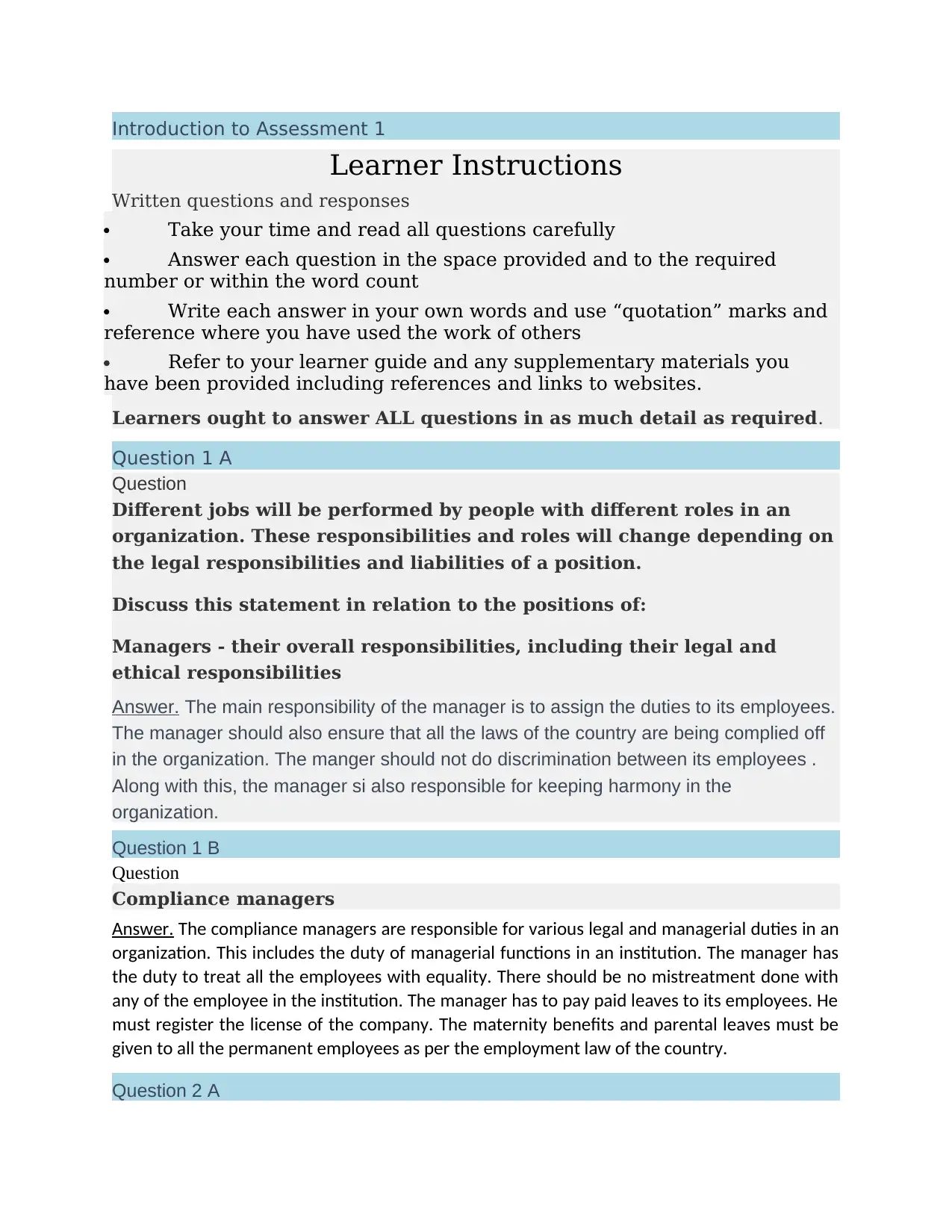
Introduction to Assessment 1
Learner Instructions
Written questions and responses
Take your time and read all questions carefully
Answer each question in the space provided and to the required
number or within the word count
Write each answer in your own words and use “quotation” marks and
reference where you have used the work of others
Refer to your learner guide and any supplementary materials you
have been provided including references and links to websites.
Learners ought to answer ALL questions in as much detail as required.
Question 1 A
Question
Different jobs will be performed by people with different roles in an
organization. These responsibilities and roles will change depending on
the legal responsibilities and liabilities of a position.
Discuss this statement in relation to the positions of:
Managers - their overall responsibilities, including their legal and
ethical responsibilities
Answer. The main responsibility of the manager is to assign the duties to its employees.
The manager should also ensure that all the laws of the country are being complied off
in the organization. The manger should not do discrimination between its employees .
Along with this, the manager si also responsible for keeping harmony in the
organization.
Question 1 B
Question
Compliance managers
Answer. The compliance managers are responsible for various legal and managerial duties in an
organization. This includes the duty of managerial functions in an institution. The manager has
the duty to treat all the employees with equality. There should be no mistreatment done with
any of the employee in the institution. The manager has to pay paid leaves to its employees. He
must register the license of the company. The maternity benefits and parental leaves must be
given to all the permanent employees as per the employment law of the country.
Question 2 A
Learner Instructions
Written questions and responses
Take your time and read all questions carefully
Answer each question in the space provided and to the required
number or within the word count
Write each answer in your own words and use “quotation” marks and
reference where you have used the work of others
Refer to your learner guide and any supplementary materials you
have been provided including references and links to websites.
Learners ought to answer ALL questions in as much detail as required.
Question 1 A
Question
Different jobs will be performed by people with different roles in an
organization. These responsibilities and roles will change depending on
the legal responsibilities and liabilities of a position.
Discuss this statement in relation to the positions of:
Managers - their overall responsibilities, including their legal and
ethical responsibilities
Answer. The main responsibility of the manager is to assign the duties to its employees.
The manager should also ensure that all the laws of the country are being complied off
in the organization. The manger should not do discrimination between its employees .
Along with this, the manager si also responsible for keeping harmony in the
organization.
Question 1 B
Question
Compliance managers
Answer. The compliance managers are responsible for various legal and managerial duties in an
organization. This includes the duty of managerial functions in an institution. The manager has
the duty to treat all the employees with equality. There should be no mistreatment done with
any of the employee in the institution. The manager has to pay paid leaves to its employees. He
must register the license of the company. The maternity benefits and parental leaves must be
given to all the permanent employees as per the employment law of the country.
Question 2 A
Paraphrase This Document
Need a fresh take? Get an instant paraphrase of this document with our AI Paraphraser
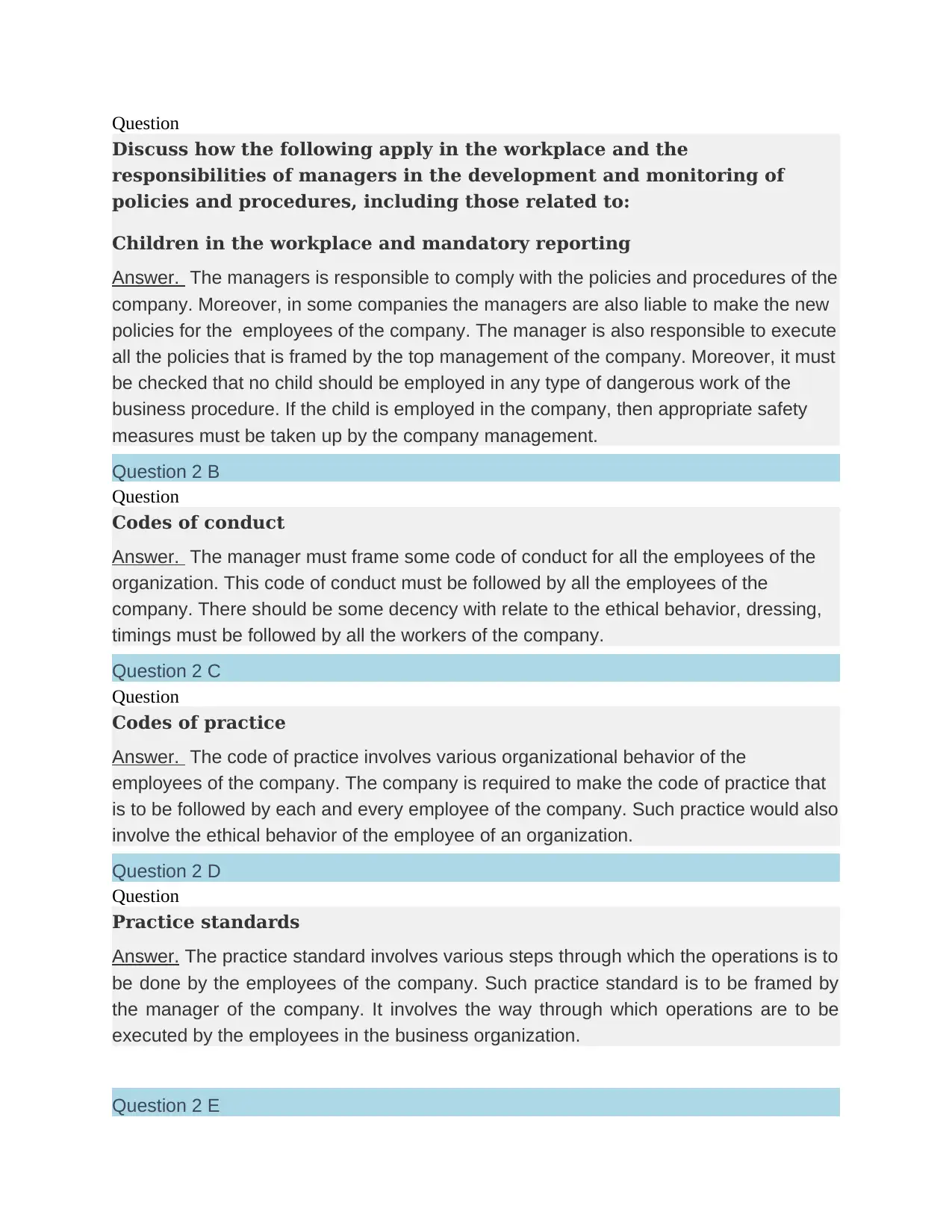
Question
Discuss how the following apply in the workplace and the
responsibilities of managers in the development and monitoring of
policies and procedures, including those related to:
Children in the workplace and mandatory reporting
Answer. The managers is responsible to comply with the policies and procedures of the
company. Moreover, in some companies the managers are also liable to make the new
policies for the employees of the company. The manager is also responsible to execute
all the policies that is framed by the top management of the company. Moreover, it must
be checked that no child should be employed in any type of dangerous work of the
business procedure. If the child is employed in the company, then appropriate safety
measures must be taken up by the company management.
Question 2 B
Question
Codes of conduct
Answer. The manager must frame some code of conduct for all the employees of the
organization. This code of conduct must be followed by all the employees of the
company. There should be some decency with relate to the ethical behavior, dressing,
timings must be followed by all the workers of the company.
Question 2 C
Question
Codes of practice
Answer. The code of practice involves various organizational behavior of the
employees of the company. The company is required to make the code of practice that
is to be followed by each and every employee of the company. Such practice would also
involve the ethical behavior of the employee of an organization.
Question 2 D
Question
Practice standards
Answer. The practice standard involves various steps through which the operations is to
be done by the employees of the company. Such practice standard is to be framed by
the manager of the company. It involves the way through which operations are to be
executed by the employees in the business organization.
Question 2 E
Discuss how the following apply in the workplace and the
responsibilities of managers in the development and monitoring of
policies and procedures, including those related to:
Children in the workplace and mandatory reporting
Answer. The managers is responsible to comply with the policies and procedures of the
company. Moreover, in some companies the managers are also liable to make the new
policies for the employees of the company. The manager is also responsible to execute
all the policies that is framed by the top management of the company. Moreover, it must
be checked that no child should be employed in any type of dangerous work of the
business procedure. If the child is employed in the company, then appropriate safety
measures must be taken up by the company management.
Question 2 B
Question
Codes of conduct
Answer. The manager must frame some code of conduct for all the employees of the
organization. This code of conduct must be followed by all the employees of the
company. There should be some decency with relate to the ethical behavior, dressing,
timings must be followed by all the workers of the company.
Question 2 C
Question
Codes of practice
Answer. The code of practice involves various organizational behavior of the
employees of the company. The company is required to make the code of practice that
is to be followed by each and every employee of the company. Such practice would also
involve the ethical behavior of the employee of an organization.
Question 2 D
Question
Practice standards
Answer. The practice standard involves various steps through which the operations is to
be done by the employees of the company. Such practice standard is to be framed by
the manager of the company. It involves the way through which operations are to be
executed by the employees in the business organization.
Question 2 E
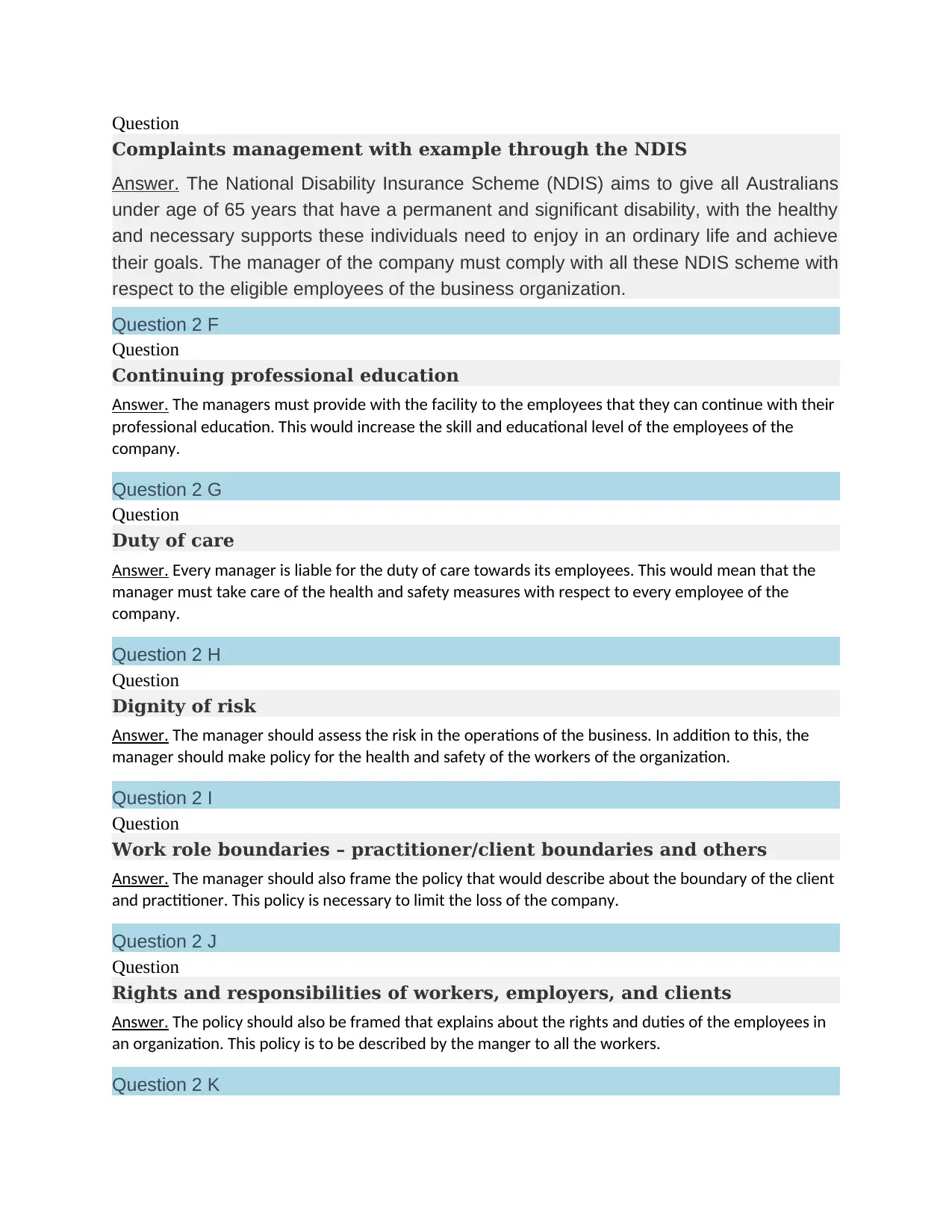
Question
Complaints management with example through the NDIS
Answer. The National Disability Insurance Scheme (NDIS) aims to give all Australians
under age of 65 years that have a permanent and significant disability, with the healthy
and necessary supports these individuals need to enjoy in an ordinary life and achieve
their goals. The manager of the company must comply with all these NDIS scheme with
respect to the eligible employees of the business organization.
Question 2 F
Question
Continuing professional education
Answer. The managers must provide with the facility to the employees that they can continue with their
professional education. This would increase the skill and educational level of the employees of the
company.
Question 2 G
Question
Duty of care
Answer. Every manager is liable for the duty of care towards its employees. This would mean that the
manager must take care of the health and safety measures with respect to every employee of the
company.
Question 2 H
Question
Dignity of risk
Answer. The manager should assess the risk in the operations of the business. In addition to this, the
manager should make policy for the health and safety of the workers of the organization.
Question 2 I
Question
Work role boundaries – practitioner/client boundaries and others
Answer. The manager should also frame the policy that would describe about the boundary of the client
and practitioner. This policy is necessary to limit the loss of the company.
Question 2 J
Question
Rights and responsibilities of workers, employers, and clients
Answer. The policy should also be framed that explains about the rights and duties of the employees in
an organization. This policy is to be described by the manger to all the workers.
Question 2 K
Complaints management with example through the NDIS
Answer. The National Disability Insurance Scheme (NDIS) aims to give all Australians
under age of 65 years that have a permanent and significant disability, with the healthy
and necessary supports these individuals need to enjoy in an ordinary life and achieve
their goals. The manager of the company must comply with all these NDIS scheme with
respect to the eligible employees of the business organization.
Question 2 F
Question
Continuing professional education
Answer. The managers must provide with the facility to the employees that they can continue with their
professional education. This would increase the skill and educational level of the employees of the
company.
Question 2 G
Question
Duty of care
Answer. Every manager is liable for the duty of care towards its employees. This would mean that the
manager must take care of the health and safety measures with respect to every employee of the
company.
Question 2 H
Question
Dignity of risk
Answer. The manager should assess the risk in the operations of the business. In addition to this, the
manager should make policy for the health and safety of the workers of the organization.
Question 2 I
Question
Work role boundaries – practitioner/client boundaries and others
Answer. The manager should also frame the policy that would describe about the boundary of the client
and practitioner. This policy is necessary to limit the loss of the company.
Question 2 J
Question
Rights and responsibilities of workers, employers, and clients
Answer. The policy should also be framed that explains about the rights and duties of the employees in
an organization. This policy is to be described by the manger to all the workers.
Question 2 K
⊘ This is a preview!⊘
Do you want full access?
Subscribe today to unlock all pages.

Trusted by 1+ million students worldwide
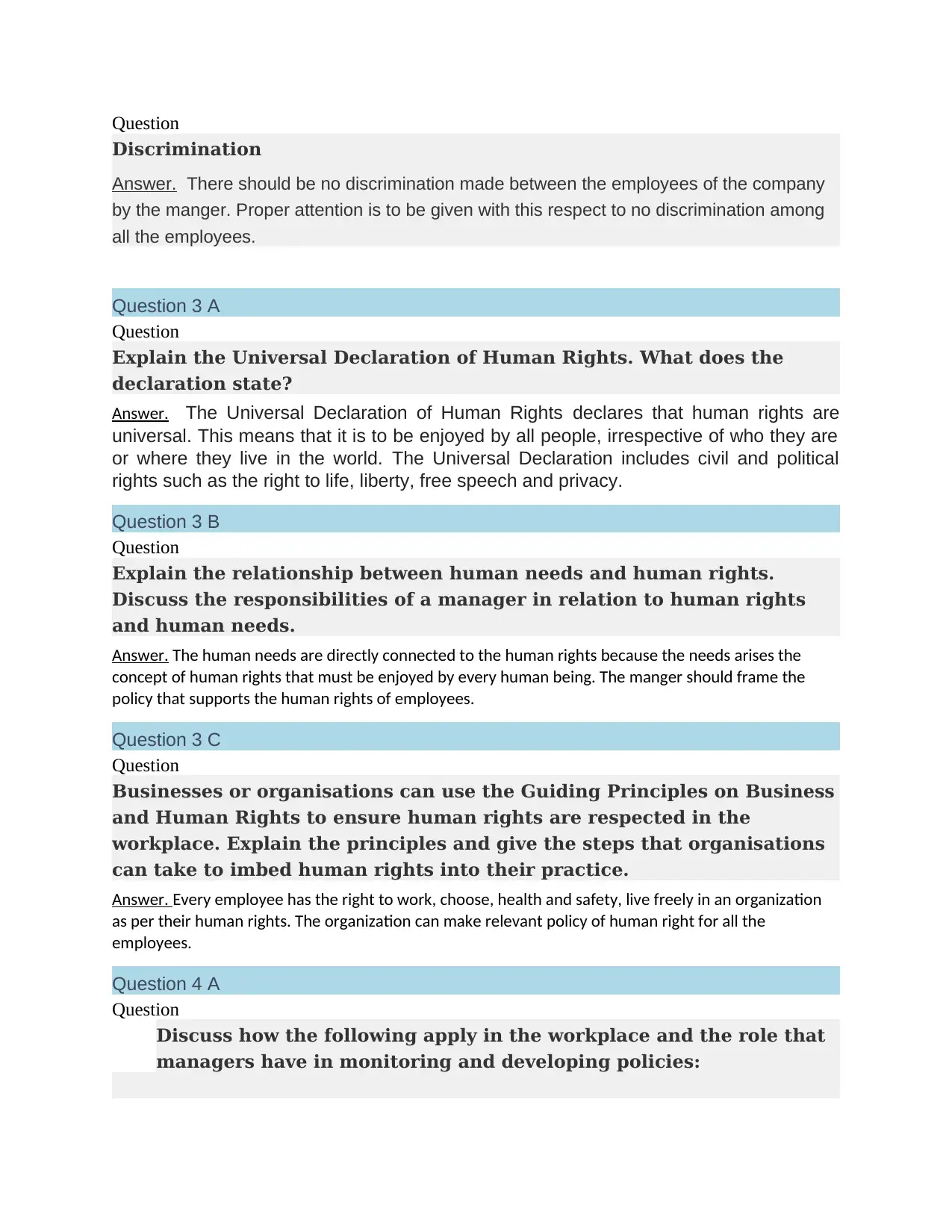
Question
Discrimination
Answer. There should be no discrimination made between the employees of the company
by the manger. Proper attention is to be given with this respect to no discrimination among
all the employees.
Question 3 A
Question
Explain the Universal Declaration of Human Rights. What does the
declaration state?
Answer. The Universal Declaration of Human Rights declares that human rights are
universal. This means that it is to be enjoyed by all people, irrespective of who they are
or where they live in the world. The Universal Declaration includes civil and political
rights such as the right to life, liberty, free speech and privacy.
Question 3 B
Question
Explain the relationship between human needs and human rights.
Discuss the responsibilities of a manager in relation to human rights
and human needs.
Answer. The human needs are directly connected to the human rights because the needs arises the
concept of human rights that must be enjoyed by every human being. The manger should frame the
policy that supports the human rights of employees.
Question 3 C
Question
Businesses or organisations can use the Guiding Principles on Business
and Human Rights to ensure human rights are respected in the
workplace. Explain the principles and give the steps that organisations
can take to imbed human rights into their practice.
Answer. Every employee has the right to work, choose, health and safety, live freely in an organization
as per their human rights. The organization can make relevant policy of human right for all the
employees.
Question 4 A
Question
Discuss how the following apply in the workplace and the role that
managers have in monitoring and developing policies:
Discrimination
Answer. There should be no discrimination made between the employees of the company
by the manger. Proper attention is to be given with this respect to no discrimination among
all the employees.
Question 3 A
Question
Explain the Universal Declaration of Human Rights. What does the
declaration state?
Answer. The Universal Declaration of Human Rights declares that human rights are
universal. This means that it is to be enjoyed by all people, irrespective of who they are
or where they live in the world. The Universal Declaration includes civil and political
rights such as the right to life, liberty, free speech and privacy.
Question 3 B
Question
Explain the relationship between human needs and human rights.
Discuss the responsibilities of a manager in relation to human rights
and human needs.
Answer. The human needs are directly connected to the human rights because the needs arises the
concept of human rights that must be enjoyed by every human being. The manger should frame the
policy that supports the human rights of employees.
Question 3 C
Question
Businesses or organisations can use the Guiding Principles on Business
and Human Rights to ensure human rights are respected in the
workplace. Explain the principles and give the steps that organisations
can take to imbed human rights into their practice.
Answer. Every employee has the right to work, choose, health and safety, live freely in an organization
as per their human rights. The organization can make relevant policy of human right for all the
employees.
Question 4 A
Question
Discuss how the following apply in the workplace and the role that
managers have in monitoring and developing policies:
Paraphrase This Document
Need a fresh take? Get an instant paraphrase of this document with our AI Paraphraser
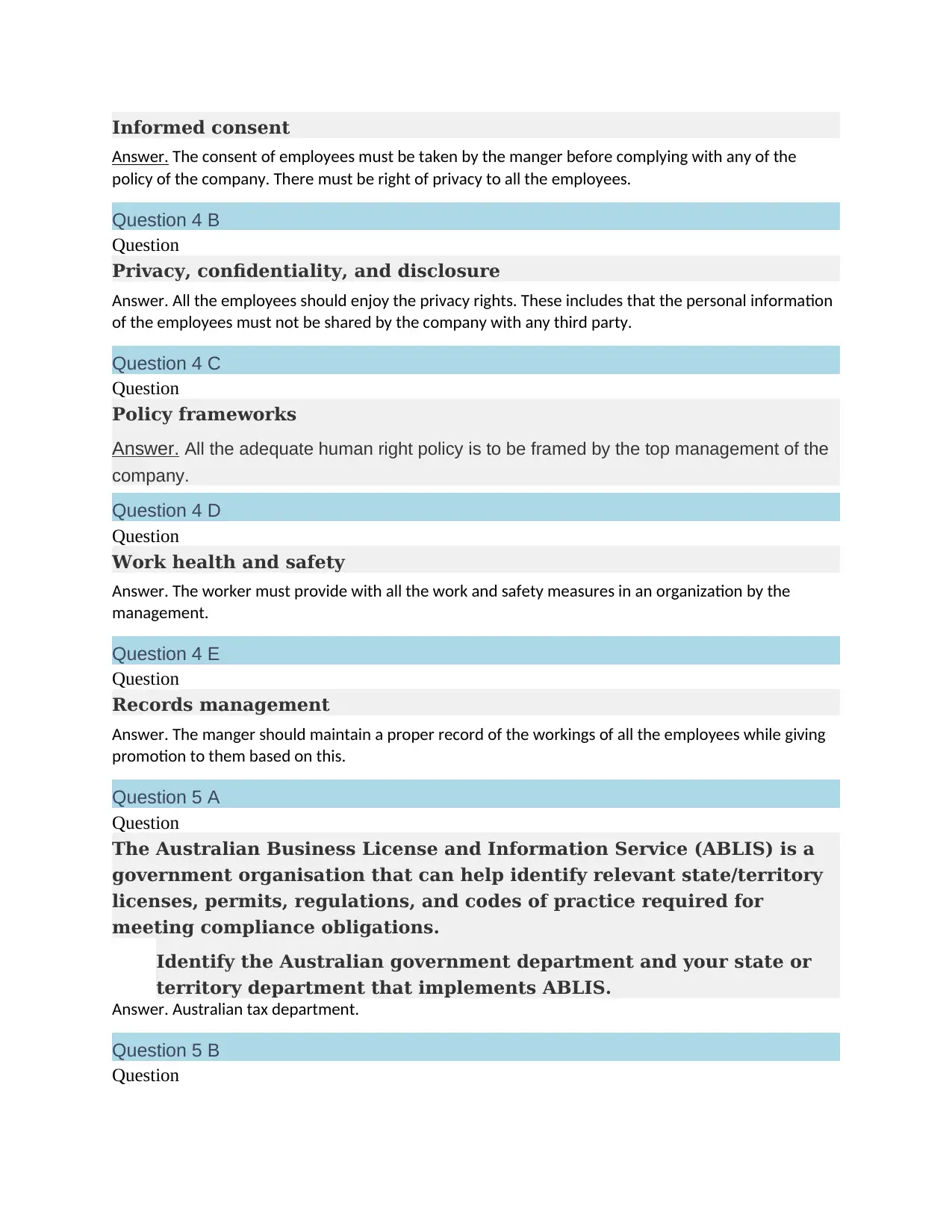
Informed consent
Answer. The consent of employees must be taken by the manger before complying with any of the
policy of the company. There must be right of privacy to all the employees.
Question 4 B
Question
Privacy, confidentiality, and disclosure
Answer. All the employees should enjoy the privacy rights. These includes that the personal information
of the employees must not be shared by the company with any third party.
Question 4 C
Question
Policy frameworks
Answer. All the adequate human right policy is to be framed by the top management of the
company.
Question 4 D
Question
Work health and safety
Answer. The worker must provide with all the work and safety measures in an organization by the
management.
Question 4 E
Question
Records management
Answer. The manger should maintain a proper record of the workings of all the employees while giving
promotion to them based on this.
Question 5 A
Question
The Australian Business License and Information Service (ABLIS) is a
government organisation that can help identify relevant state/territory
licenses, permits, regulations, and codes of practice required for
meeting compliance obligations.
Identify the Australian government department and your state or
territory department that implements ABLIS.
Answer. Australian tax department.
Question 5 B
Question
Answer. The consent of employees must be taken by the manger before complying with any of the
policy of the company. There must be right of privacy to all the employees.
Question 4 B
Question
Privacy, confidentiality, and disclosure
Answer. All the employees should enjoy the privacy rights. These includes that the personal information
of the employees must not be shared by the company with any third party.
Question 4 C
Question
Policy frameworks
Answer. All the adequate human right policy is to be framed by the top management of the
company.
Question 4 D
Question
Work health and safety
Answer. The worker must provide with all the work and safety measures in an organization by the
management.
Question 4 E
Question
Records management
Answer. The manger should maintain a proper record of the workings of all the employees while giving
promotion to them based on this.
Question 5 A
Question
The Australian Business License and Information Service (ABLIS) is a
government organisation that can help identify relevant state/territory
licenses, permits, regulations, and codes of practice required for
meeting compliance obligations.
Identify the Australian government department and your state or
territory department that implements ABLIS.
Answer. Australian tax department.
Question 5 B
Question
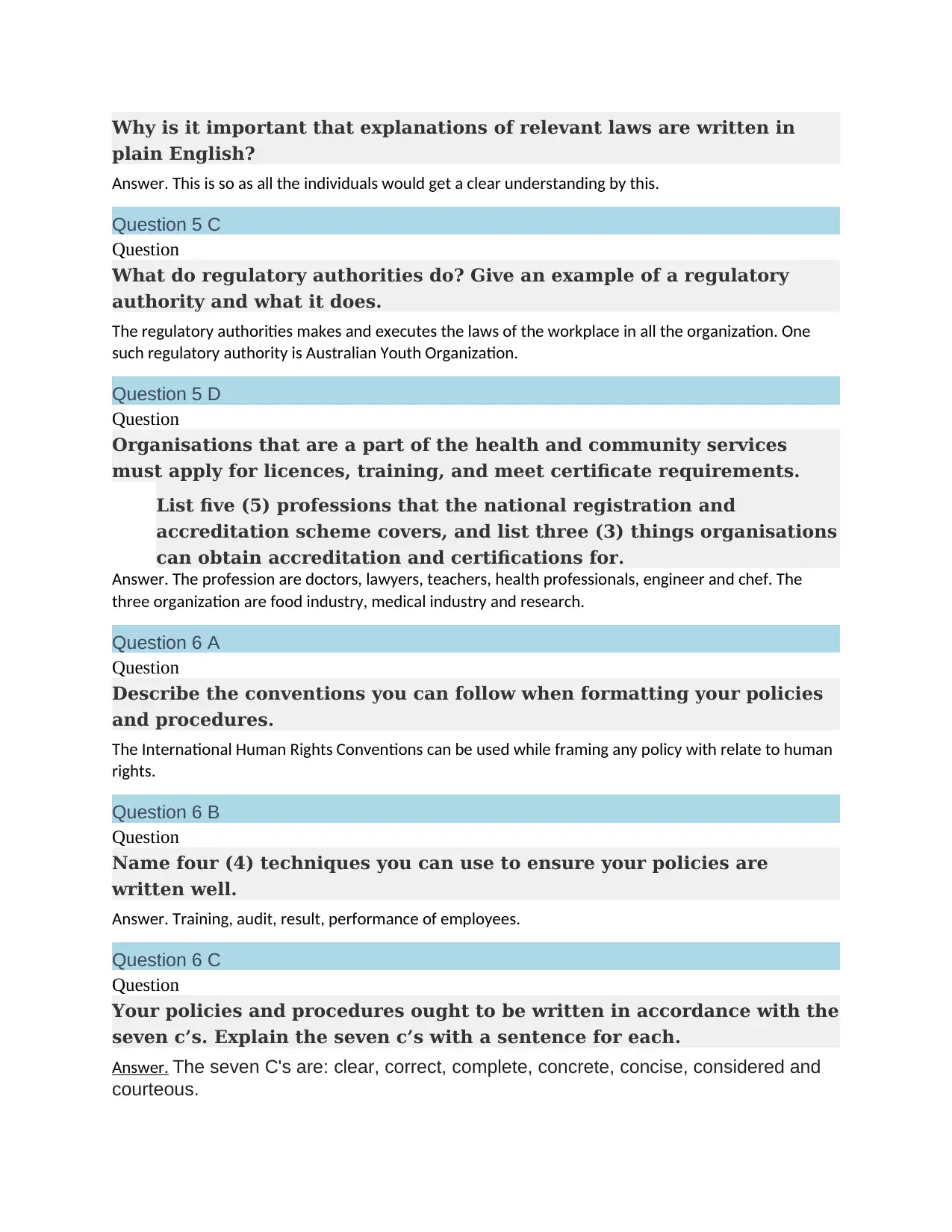
Why is it important that explanations of relevant laws are written in
plain English?
Answer. This is so as all the individuals would get a clear understanding by this.
Question 5 C
Question
What do regulatory authorities do? Give an example of a regulatory
authority and what it does.
The regulatory authorities makes and executes the laws of the workplace in all the organization. One
such regulatory authority is Australian Youth Organization.
Question 5 D
Question
Organisations that are a part of the health and community services
must apply for licences, training, and meet certificate requirements.
List five (5) professions that the national registration and
accreditation scheme covers, and list three (3) things organisations
can obtain accreditation and certifications for.
Answer. The profession are doctors, lawyers, teachers, health professionals, engineer and chef. The
three organization are food industry, medical industry and research.
Question 6 A
Question
Describe the conventions you can follow when formatting your policies
and procedures.
The International Human Rights Conventions can be used while framing any policy with relate to human
rights.
Question 6 B
Question
Name four (4) techniques you can use to ensure your policies are
written well.
Answer. Training, audit, result, performance of employees.
Question 6 C
Question
Your policies and procedures ought to be written in accordance with the
seven c’s. Explain the seven c’s with a sentence for each.
Answer. The seven C's are: clear, correct, complete, concrete, concise, considered and
courteous.
plain English?
Answer. This is so as all the individuals would get a clear understanding by this.
Question 5 C
Question
What do regulatory authorities do? Give an example of a regulatory
authority and what it does.
The regulatory authorities makes and executes the laws of the workplace in all the organization. One
such regulatory authority is Australian Youth Organization.
Question 5 D
Question
Organisations that are a part of the health and community services
must apply for licences, training, and meet certificate requirements.
List five (5) professions that the national registration and
accreditation scheme covers, and list three (3) things organisations
can obtain accreditation and certifications for.
Answer. The profession are doctors, lawyers, teachers, health professionals, engineer and chef. The
three organization are food industry, medical industry and research.
Question 6 A
Question
Describe the conventions you can follow when formatting your policies
and procedures.
The International Human Rights Conventions can be used while framing any policy with relate to human
rights.
Question 6 B
Question
Name four (4) techniques you can use to ensure your policies are
written well.
Answer. Training, audit, result, performance of employees.
Question 6 C
Question
Your policies and procedures ought to be written in accordance with the
seven c’s. Explain the seven c’s with a sentence for each.
Answer. The seven C's are: clear, correct, complete, concrete, concise, considered and
courteous.
⊘ This is a preview!⊘
Do you want full access?
Subscribe today to unlock all pages.

Trusted by 1+ million students worldwide
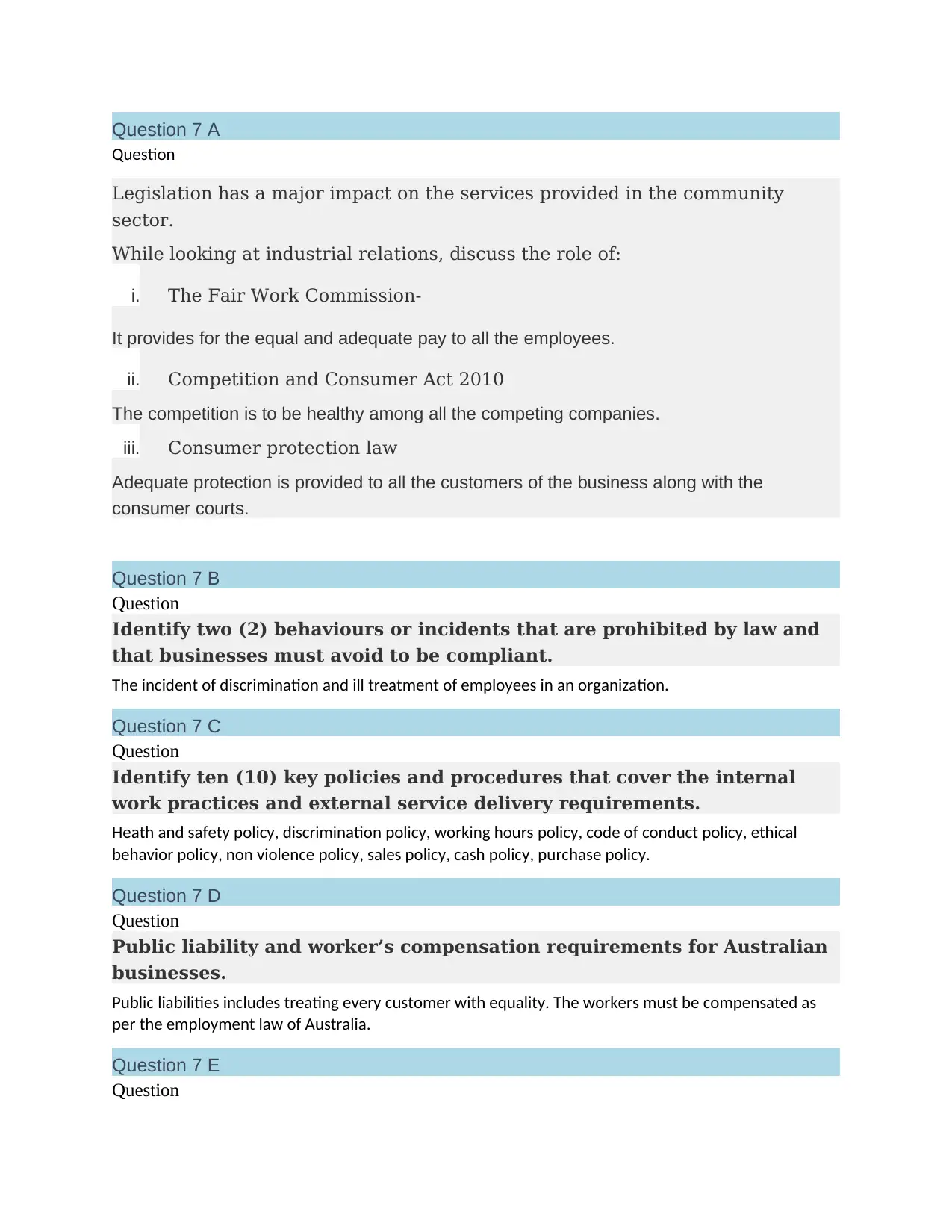
Question 7 A
Question
Legislation has a major impact on the services provided in the community
sector.
While looking at industrial relations, discuss the role of:
i. The Fair Work Commission-
It provides for the equal and adequate pay to all the employees.
ii. Competition and Consumer Act 2010
The competition is to be healthy among all the competing companies.
iii. Consumer protection law
Adequate protection is provided to all the customers of the business along with the
consumer courts.
Question 7 B
Question
Identify two (2) behaviours or incidents that are prohibited by law and
that businesses must avoid to be compliant.
The incident of discrimination and ill treatment of employees in an organization.
Question 7 C
Question
Identify ten (10) key policies and procedures that cover the internal
work practices and external service delivery requirements.
Heath and safety policy, discrimination policy, working hours policy, code of conduct policy, ethical
behavior policy, non violence policy, sales policy, cash policy, purchase policy.
Question 7 D
Question
Public liability and worker’s compensation requirements for Australian
businesses.
Public liabilities includes treating every customer with equality. The workers must be compensated as
per the employment law of Australia.
Question 7 E
Question
Question
Legislation has a major impact on the services provided in the community
sector.
While looking at industrial relations, discuss the role of:
i. The Fair Work Commission-
It provides for the equal and adequate pay to all the employees.
ii. Competition and Consumer Act 2010
The competition is to be healthy among all the competing companies.
iii. Consumer protection law
Adequate protection is provided to all the customers of the business along with the
consumer courts.
Question 7 B
Question
Identify two (2) behaviours or incidents that are prohibited by law and
that businesses must avoid to be compliant.
The incident of discrimination and ill treatment of employees in an organization.
Question 7 C
Question
Identify ten (10) key policies and procedures that cover the internal
work practices and external service delivery requirements.
Heath and safety policy, discrimination policy, working hours policy, code of conduct policy, ethical
behavior policy, non violence policy, sales policy, cash policy, purchase policy.
Question 7 D
Question
Public liability and worker’s compensation requirements for Australian
businesses.
Public liabilities includes treating every customer with equality. The workers must be compensated as
per the employment law of Australia.
Question 7 E
Question
Paraphrase This Document
Need a fresh take? Get an instant paraphrase of this document with our AI Paraphraser
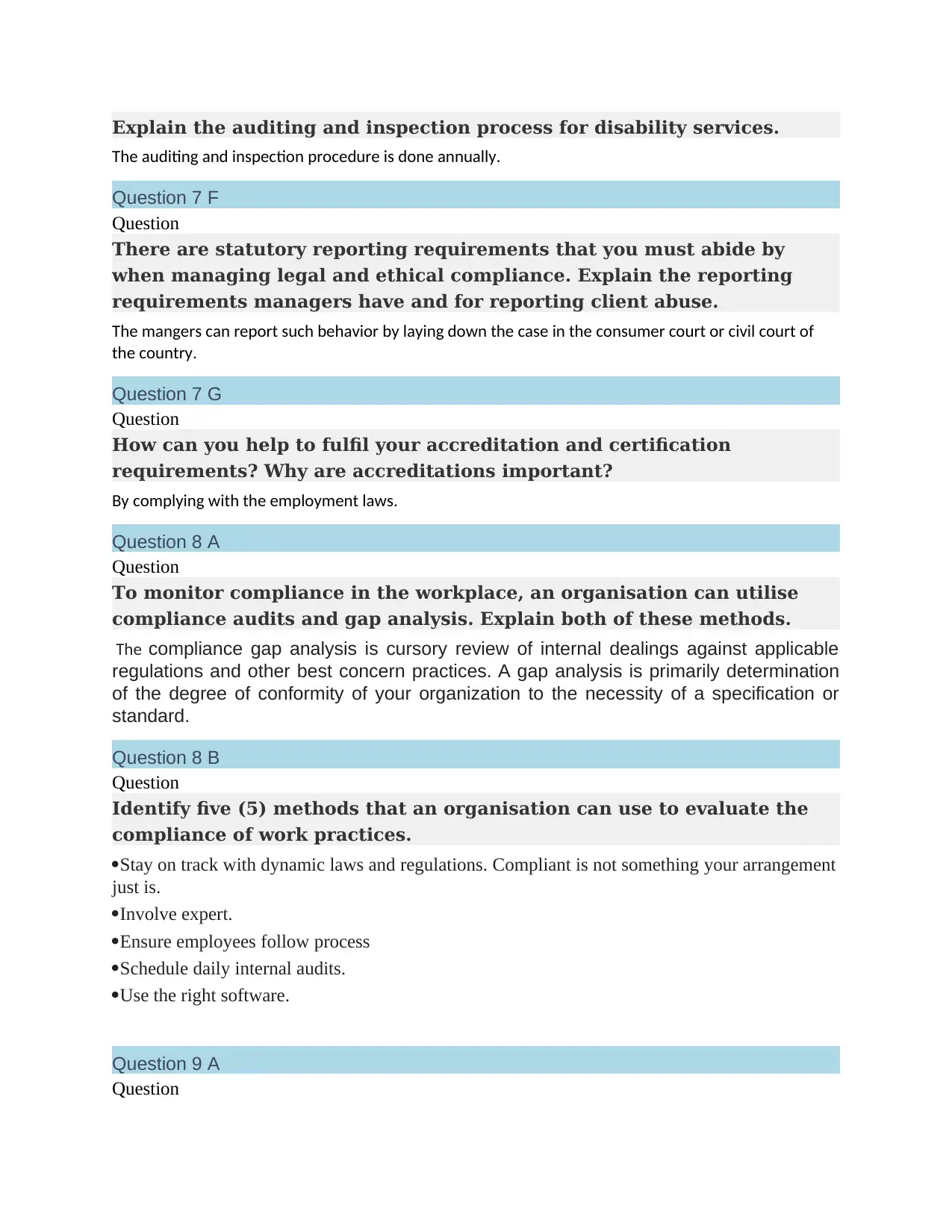
Explain the auditing and inspection process for disability services.
The auditing and inspection procedure is done annually.
Question 7 F
Question
There are statutory reporting requirements that you must abide by
when managing legal and ethical compliance. Explain the reporting
requirements managers have and for reporting client abuse.
The mangers can report such behavior by laying down the case in the consumer court or civil court of
the country.
Question 7 G
Question
How can you help to fulfil your accreditation and certification
requirements? Why are accreditations important?
By complying with the employment laws.
Question 8 A
Question
To monitor compliance in the workplace, an organisation can utilise
compliance audits and gap analysis. Explain both of these methods.
The compliance gap analysis is cursory review of internal dealings against applicable
regulations and other best concern practices. A gap analysis is primarily determination
of the degree of conformity of your organization to the necessity of a specification or
standard.
Question 8 B
Question
Identify five (5) methods that an organisation can use to evaluate the
compliance of work practices.
Stay on track with dynamic laws and regulations. Compliant is not something your arrangement
just is.
Involve expert.
Ensure employees follow process
Schedule daily internal audits.
Use the right software.
Question 9 A
Question
The auditing and inspection procedure is done annually.
Question 7 F
Question
There are statutory reporting requirements that you must abide by
when managing legal and ethical compliance. Explain the reporting
requirements managers have and for reporting client abuse.
The mangers can report such behavior by laying down the case in the consumer court or civil court of
the country.
Question 7 G
Question
How can you help to fulfil your accreditation and certification
requirements? Why are accreditations important?
By complying with the employment laws.
Question 8 A
Question
To monitor compliance in the workplace, an organisation can utilise
compliance audits and gap analysis. Explain both of these methods.
The compliance gap analysis is cursory review of internal dealings against applicable
regulations and other best concern practices. A gap analysis is primarily determination
of the degree of conformity of your organization to the necessity of a specification or
standard.
Question 8 B
Question
Identify five (5) methods that an organisation can use to evaluate the
compliance of work practices.
Stay on track with dynamic laws and regulations. Compliant is not something your arrangement
just is.
Involve expert.
Ensure employees follow process
Schedule daily internal audits.
Use the right software.
Question 9 A
Question
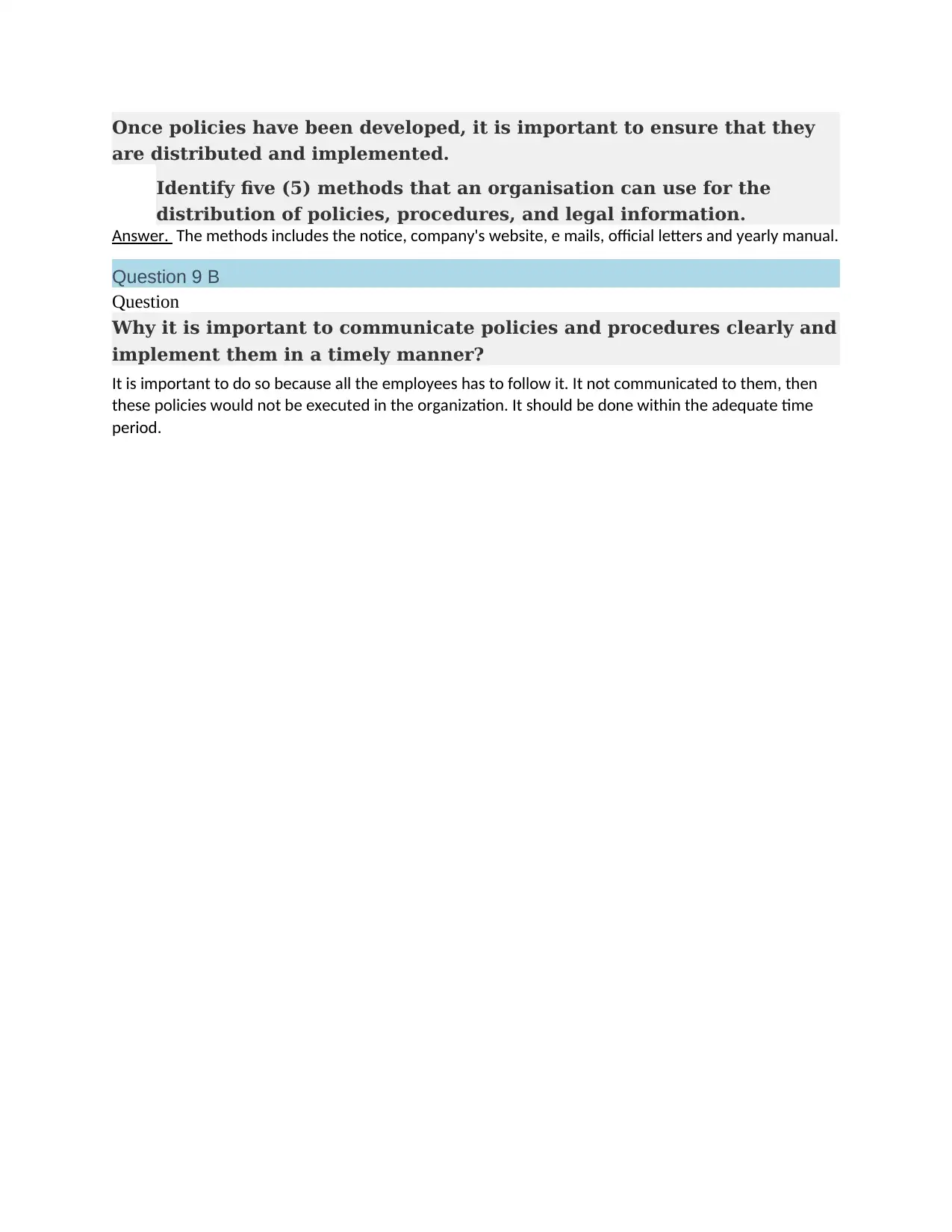
Once policies have been developed, it is important to ensure that they
are distributed and implemented.
Identify five (5) methods that an organisation can use for the
distribution of policies, procedures, and legal information.
Answer. The methods includes the notice, company's website, e mails, official letters and yearly manual.
Question 9 B
Question
Why it is important to communicate policies and procedures clearly and
implement them in a timely manner?
It is important to do so because all the employees has to follow it. It not communicated to them, then
these policies would not be executed in the organization. It should be done within the adequate time
period.
are distributed and implemented.
Identify five (5) methods that an organisation can use for the
distribution of policies, procedures, and legal information.
Answer. The methods includes the notice, company's website, e mails, official letters and yearly manual.
Question 9 B
Question
Why it is important to communicate policies and procedures clearly and
implement them in a timely manner?
It is important to do so because all the employees has to follow it. It not communicated to them, then
these policies would not be executed in the organization. It should be done within the adequate time
period.
⊘ This is a preview!⊘
Do you want full access?
Subscribe today to unlock all pages.

Trusted by 1+ million students worldwide
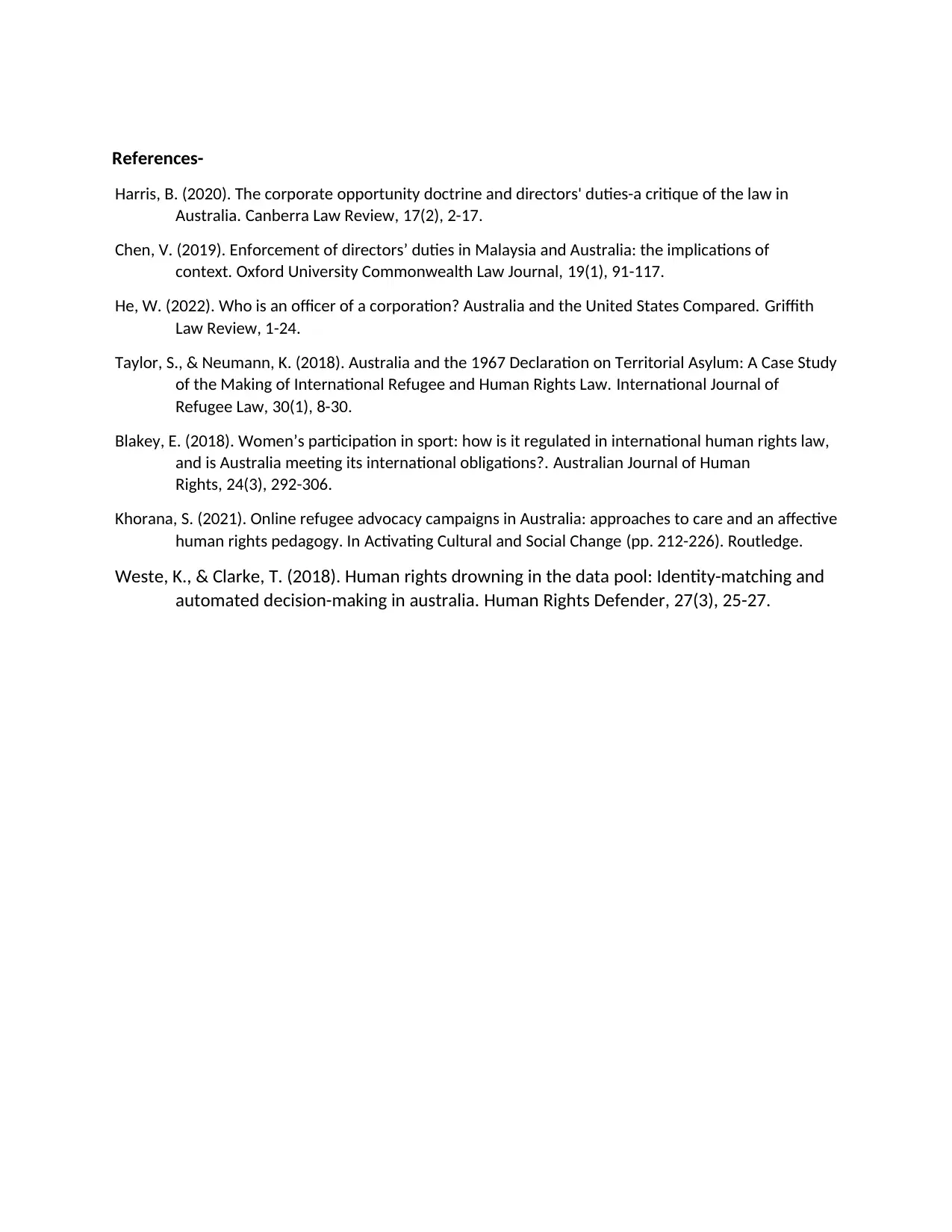
References-
Harris, B. (2020). The corporate opportunity doctrine and directors' duties-a critique of the law in
Australia. Canberra Law Review, 17(2), 2-17.
Chen, V. (2019). Enforcement of directors’ duties in Malaysia and Australia: the implications of
context. Oxford University Commonwealth Law Journal, 19(1), 91-117.
He, W. (2022). Who is an officer of a corporation? Australia and the United States Compared. Griffith
Law Review, 1-24.
Taylor, S., & Neumann, K. (2018). Australia and the 1967 Declaration on Territorial Asylum: A Case Study
of the Making of International Refugee and Human Rights Law. International Journal of
Refugee Law, 30(1), 8-30.
Blakey, E. (2018). Women’s participation in sport: how is it regulated in international human rights law,
and is Australia meeting its international obligations?. Australian Journal of Human
Rights, 24(3), 292-306.
Khorana, S. (2021). Online refugee advocacy campaigns in Australia: approaches to care and an affective
human rights pedagogy. In Activating Cultural and Social Change (pp. 212-226). Routledge.
Weste, K., & Clarke, T. (2018). Human rights drowning in the data pool: Identity-matching and
automated decision-making in australia. Human Rights Defender, 27(3), 25-27.
Harris, B. (2020). The corporate opportunity doctrine and directors' duties-a critique of the law in
Australia. Canberra Law Review, 17(2), 2-17.
Chen, V. (2019). Enforcement of directors’ duties in Malaysia and Australia: the implications of
context. Oxford University Commonwealth Law Journal, 19(1), 91-117.
He, W. (2022). Who is an officer of a corporation? Australia and the United States Compared. Griffith
Law Review, 1-24.
Taylor, S., & Neumann, K. (2018). Australia and the 1967 Declaration on Territorial Asylum: A Case Study
of the Making of International Refugee and Human Rights Law. International Journal of
Refugee Law, 30(1), 8-30.
Blakey, E. (2018). Women’s participation in sport: how is it regulated in international human rights law,
and is Australia meeting its international obligations?. Australian Journal of Human
Rights, 24(3), 292-306.
Khorana, S. (2021). Online refugee advocacy campaigns in Australia: approaches to care and an affective
human rights pedagogy. In Activating Cultural and Social Change (pp. 212-226). Routledge.
Weste, K., & Clarke, T. (2018). Human rights drowning in the data pool: Identity-matching and
automated decision-making in australia. Human Rights Defender, 27(3), 25-27.
1 out of 10
Related Documents
Your All-in-One AI-Powered Toolkit for Academic Success.
+13062052269
info@desklib.com
Available 24*7 on WhatsApp / Email
![[object Object]](/_next/static/media/star-bottom.7253800d.svg)
Unlock your academic potential
Copyright © 2020–2025 A2Z Services. All Rights Reserved. Developed and managed by ZUCOL.





